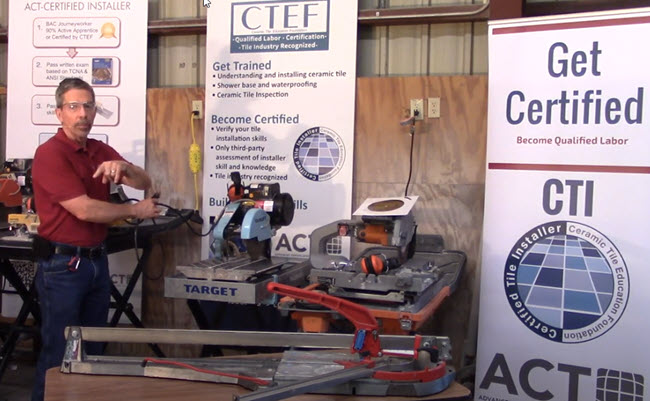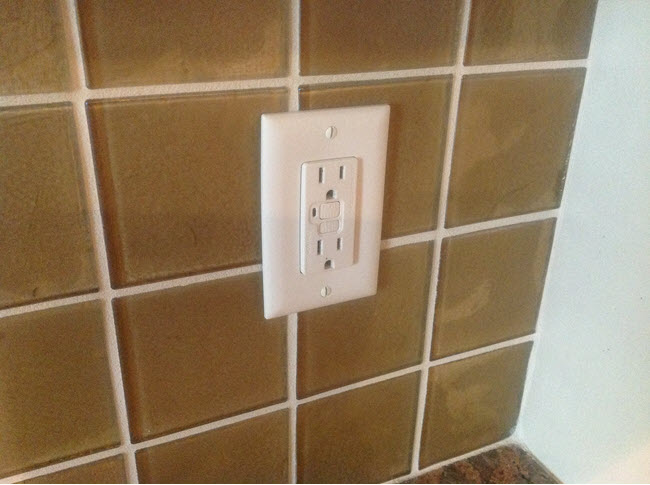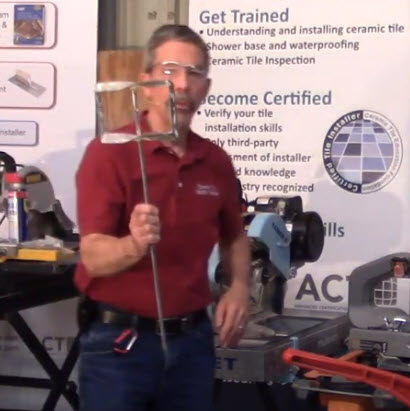
Have you considered that how you manage your tile tools affects how you manage your time? It's a similar thought process to how you go about cutting tile.
Those who are Qualified Labor constantly think about how to manage time. After all, time is money. How well you make use of that time affects how long it takes you to complete tile installations, the quality of your work, and how many client projects you can commit to.
This is true with how you manage your tools.
How You Manage Tile Tools Affects Time
You see, time management has a lot to do with the equipment used every day and how you care for them. Here are 8 examples demonstrating how taking care of your tools can save you time on your tile installation projects.
1. Do You Have a Backup Cutter Wheel?
Do you have a cutter? A great cutter does a great job of cutting tile. In fact, using one is much more efficient when you're making all straight cuts than a wet saw is.
If your cutter goes down, and you lose the quality of the wheel because it's damaged in some way, and your shop where you have spare wheels is thirty miles away, you're out of a cutter.
The best solution is to always put an extra wheel on the back of the cutter. Just tape it in there and forget it.
Then, whenever you have a wheel that may go bad, you can immediately put the cutter back together and you're back in business, and no time lost.
2. What Do You Plug Your Wet Saw Into?
A wet saw is ideal for L cuts and intricate tile cuts. It, too, has quality parts that must be maintained for good results.
Make sure your wet saw is always plugged into a GFCI - a ground fault circuit interrupter:
"The ground-fault circuit interrupter, or GFCI, is a fast-acting circuit breaker designed to shut off electric power in the event of a ground fault within as little as 1/40 of a second. It works by comparing the amount of current going to and returning from equipment along the circuit conductors. When the amount going differs from the amount returning by approximately 5 milliamperes, the GFCI interrupts the current."
GFCIs can prevent injury and/or death in the case of an electrical ground fault.
Make sure you plug the GFCI into the receptacle at the panel or the wall, never at the end of the extension cord because it's not effective there.
If you do maintenance on your wet saw, though, be sure to disconnect it from the GFCI so you remain safe.

3. Is Your Wet Saw Lubricated?
Check out the wet saw tray. It needs to be kept well lubricated to produce quality cuts. To do so, add a small quantity of lubricant to the wheels on the back.
That ensures that the mechanism works effectively so you can easily make cuts.
Note to always have lubricant available on-site and in your truck.
4. Do You Have a Spare Wet Saw Blade?
Next, examine the saw blade. Just as with the cutter, if you don't have a blade that is properly fitted and in good condition, it can wobble.
That can happen if somebody gets into the truck, banging the side of the blade, and warping it. The warp adds a wiggle which then causes chipped tile.
To prevent that situation, put a 3/8" or 1/2" bolt somewhere in the truck, put the blade through it, and add a wing nut or clevis pin to keep that blade nice and safe.
In addition, always have a spare blade that can be tucked into the back of your truck in case you need it if something does get damaged on the job.
5. How's Your Glass Blade?
The most important of all blades is your glass blade, the one that is specific to the glass work you do. Tuck that one to the back of your truck, so it's not one that your helper will readily grab and use.
There, too, have a backup so your work doesn't have to come to a standstill when your glass blade stops making clean, exact cuts.
>> See How To Install Glass Tile Correctly
6. Do You Have an Extra Wet Saw Pump?
The last item on this wet saw that must function is the pump.
You don't want to wait until that pump is so far entrenched in sludge that you must use a margin trowel to dig it out.
Instead, take care of that pump at the end of the day. Pop it into a bucket of water, let the water run for a minute or two to clean all the debris out. That way you have a really good and clean operating pump.
Here, too, it's always good to have a spare pump on the shelf in the truck. That way, if the pump goes bad, you're still in really good shape for the work you need to do.

7. How Well-Maintained is Your Mixer?
Next, make sure your mixer is well-maintained. Check that the cord isn't damaged in any way and that you've got a mixing paddle on the end that's cleaned up every day at the end of the job.
If you don't spin the paddle in a bucket of water at the end of each day, you'll wind up with a paddle that's a real mess just because somebody was too lazy to clean it up spin. In that case, you can spin it in sand to get it cleaned up.
A clean paddle works much better for mixing materials.
It also takes less time to keep up with cleaning your paddle.
8. Banish the Drywall Paddle!
Perhaps most important is making sure that you use the right tools for the job.
For example, there's no place in a tile installer's toolbox for a drywall paddle. This paddle is for mixing joint compound and not thinset.
Here are the issues associated with using the wrong tool in this case:
- It throws thinset all over you
- Worse - it whips excessive air into the mix, weakening the thinset.
Watch the Video on Managing Your Tile Tools
Here's the 4:40-minute video where Scott Carothers demonstrates these time-saving tips for managing your tools.
As you'll see, if you take care of all these items - your cutter, wet saw, and mixer - you'll have more time on the job to do the work of Qualified Labor.
How Do You Manage Your Tile Tools?
As a tile installer, everything you do is about time management. If you can do your installation faster with equal or better quality, you're in a better position. That's true when caring for and managing your tools.
It shouldn't come as a surprise that the hands-on test for the Certified Tile Installer program places a great deal of attention on time management and how you plan out the various elements of your installation.
>> See Grading the Toughest 25 Square Feet of Tile You'll Ever Install (Video)
What helps you save time? Let us know in the comments.
Thanks for reading!
Note: We originally published this article on June 30, 2020, and have updated it.

